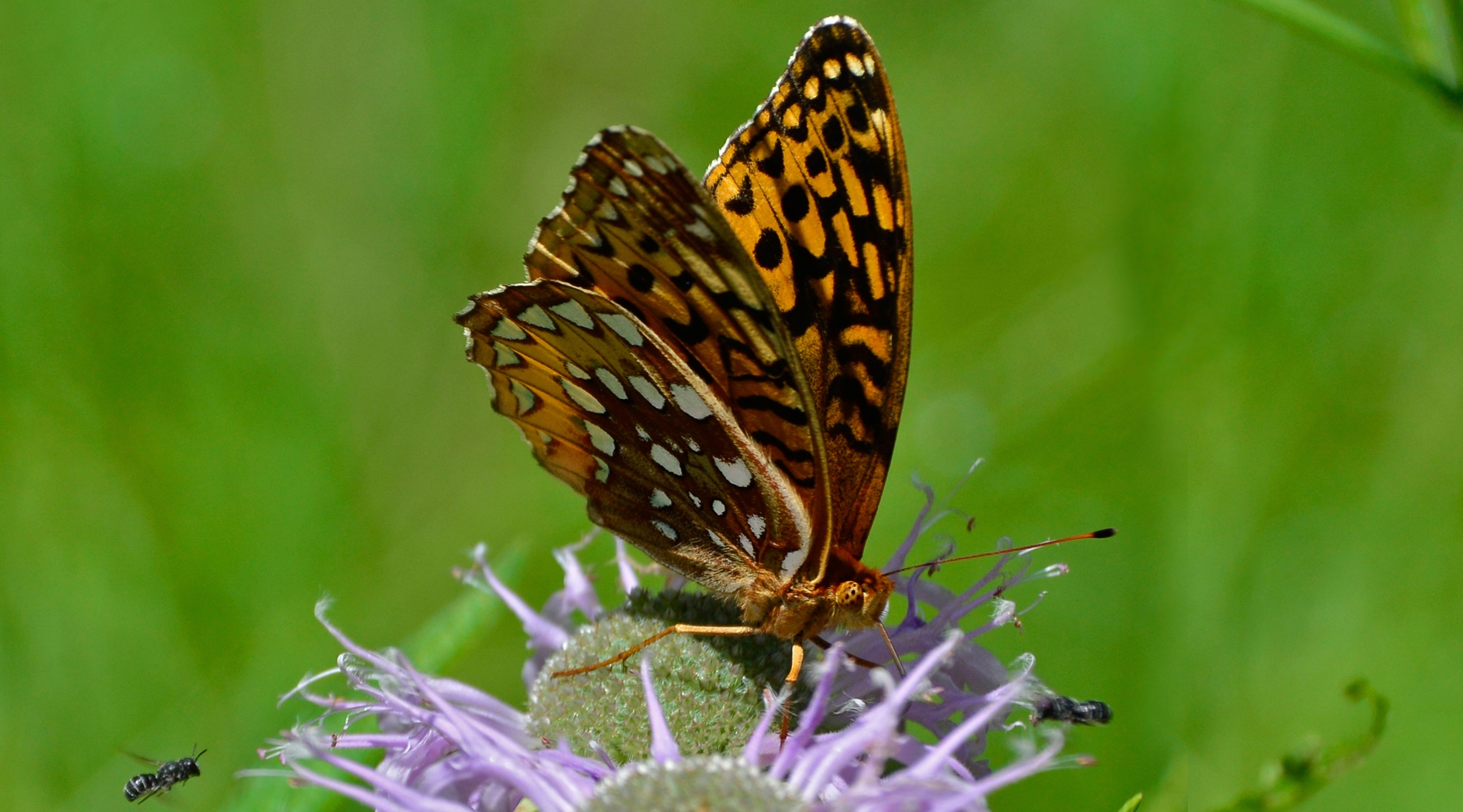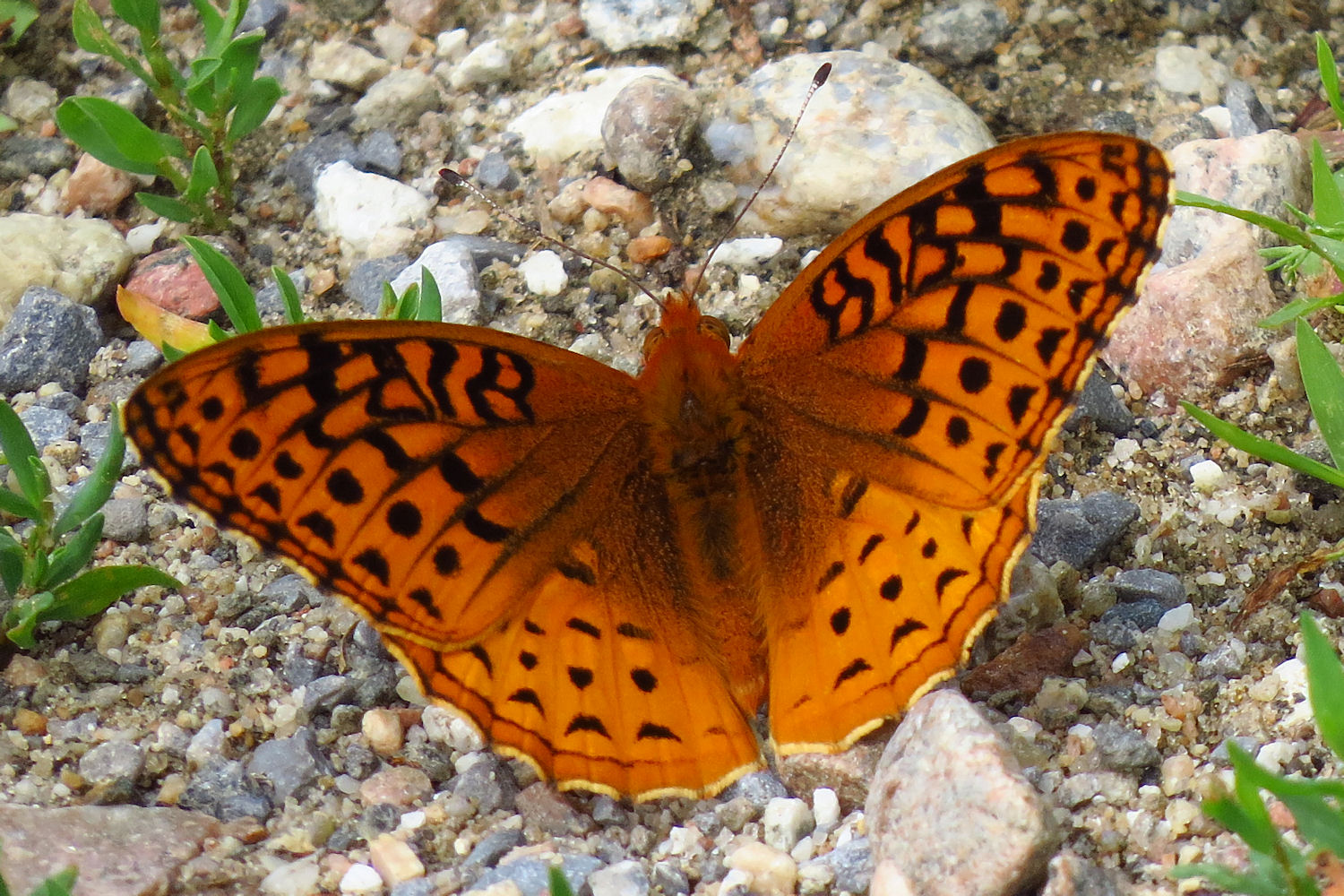great spangled fritillary on:
[Wikipedia]
[Google]
[Amazon]
The great spangled fritillary (''Speyeria cybele'') is a North American
 Its wingspan ranges from . It is characterized by its orange color above with five black dashes near forewing base and several irregular black dashes at the base of the hindwing. In addition, two rows of black crescents run along the edges of the wings. Below, the forewing is yellowish orange with black marks similar to the upperside, with a few silver spots on the tip of the wing. The hindwing is reddish brown with silver spots on the base and middle of the wing. A broad yellow band and silver triangles are the most notable qualities on the wing, next to the brown margin. Females tend to be darker than males and individuals from the western reaches of this species range tend to be brighter orange. Similar species include the Aphrodite fritillary ('' Speyeria aphrodite''), the Atlantis fritillary ('' Speyeria atlantis'') and the northwestern fritillary ('' Speyeria hesperis''). It is distinguished from the
Its wingspan ranges from . It is characterized by its orange color above with five black dashes near forewing base and several irregular black dashes at the base of the hindwing. In addition, two rows of black crescents run along the edges of the wings. Below, the forewing is yellowish orange with black marks similar to the upperside, with a few silver spots on the tip of the wing. The hindwing is reddish brown with silver spots on the base and middle of the wing. A broad yellow band and silver triangles are the most notable qualities on the wing, next to the brown margin. Females tend to be darker than males and individuals from the western reaches of this species range tend to be brighter orange. Similar species include the Aphrodite fritillary ('' Speyeria aphrodite''), the Atlantis fritillary ('' Speyeria atlantis'') and the northwestern fritillary ('' Speyeria hesperis''). It is distinguished from the
 Listed alphabetically:
*''S. c. carpenterii'' (Edwards, 1876)
*''S. c. charlottii'' (Barnes, 1897)
*''S. c. cybele'' (Fabricius, 1775)
*''S. c. krautwurmi'' (Holland, 1931) – Krautwurm's fritillary
*''S. c. leto'' (Behr, 1862)
*''S. c. letona'' dos Passos & Grey, 1945
*''S. c. novascotiae'' (McDunnough, 1935)
*''S. c. pseudocarpenteri'' (F. & R. Chermock, 1940)
*''S. c. pugetensis'' Chermock & Frechin, 1947
Listed alphabetically:
*''S. c. carpenterii'' (Edwards, 1876)
*''S. c. charlottii'' (Barnes, 1897)
*''S. c. cybele'' (Fabricius, 1775)
*''S. c. krautwurmi'' (Holland, 1931) – Krautwurm's fritillary
*''S. c. leto'' (Behr, 1862)
*''S. c. letona'' dos Passos & Grey, 1945
*''S. c. novascotiae'' (McDunnough, 1935)
*''S. c. pseudocarpenteri'' (F. & R. Chermock, 1940)
*''S. c. pugetensis'' Chermock & Frechin, 1947
Great Spangled Fritillary
Wisconsin Butterflies
Speyeria cybele
North American Butterflies and Moths * The National Audubon Society Field Guide to Butterflies, by Robert Micheal Pyle {{Taxonbar, from=Q683961 Speyeria Butterflies of North America Butterflies described in 1775
butterfly
Butterflies are insects in the macrolepidopteran clade Rhopalocera from the order Lepidoptera, which also includes moths. Adult butterflies have large, often brightly coloured wings, and conspicuous, fluttering flight. The group comprise ...
of the family Nymphalidae
The Nymphalidae are the largest family of butterflies, with more than 6,000 species distributed throughout most of the world. Belonging to the superfamily Papilionoidea, they are usually medium-sized to large butterflies. Most species have a red ...
.
Description
 Its wingspan ranges from . It is characterized by its orange color above with five black dashes near forewing base and several irregular black dashes at the base of the hindwing. In addition, two rows of black crescents run along the edges of the wings. Below, the forewing is yellowish orange with black marks similar to the upperside, with a few silver spots on the tip of the wing. The hindwing is reddish brown with silver spots on the base and middle of the wing. A broad yellow band and silver triangles are the most notable qualities on the wing, next to the brown margin. Females tend to be darker than males and individuals from the western reaches of this species range tend to be brighter orange. Similar species include the Aphrodite fritillary ('' Speyeria aphrodite''), the Atlantis fritillary ('' Speyeria atlantis'') and the northwestern fritillary ('' Speyeria hesperis''). It is distinguished from the
Its wingspan ranges from . It is characterized by its orange color above with five black dashes near forewing base and several irregular black dashes at the base of the hindwing. In addition, two rows of black crescents run along the edges of the wings. Below, the forewing is yellowish orange with black marks similar to the upperside, with a few silver spots on the tip of the wing. The hindwing is reddish brown with silver spots on the base and middle of the wing. A broad yellow band and silver triangles are the most notable qualities on the wing, next to the brown margin. Females tend to be darker than males and individuals from the western reaches of this species range tend to be brighter orange. Similar species include the Aphrodite fritillary ('' Speyeria aphrodite''), the Atlantis fritillary ('' Speyeria atlantis'') and the northwestern fritillary ('' Speyeria hesperis''). It is distinguished from the Aphrodite
Aphrodite ( ; grc-gre, Ἀφροδίτη, Aphrodítē; , , ) is an ancient Greek goddess associated with love, lust, beauty, pleasure, passion, and procreation. She was syncretized with the Roman goddess . Aphrodite's major symbols inclu ...
and Atlantis
Atlantis ( grc, Ἀτλαντὶς νῆσος, , island of Atlas) is a fictional island mentioned in an allegory on the hubris of nations in Plato's works '' Timaeus'' and '' Critias'', wherein it represents the antagonist naval power that b ...
fritillaries by a wide light submarginal band on the hindwing and instead of black spots, black dashes form on the margins of the forewing.
Subspecies
 Listed alphabetically:
*''S. c. carpenterii'' (Edwards, 1876)
*''S. c. charlottii'' (Barnes, 1897)
*''S. c. cybele'' (Fabricius, 1775)
*''S. c. krautwurmi'' (Holland, 1931) – Krautwurm's fritillary
*''S. c. leto'' (Behr, 1862)
*''S. c. letona'' dos Passos & Grey, 1945
*''S. c. novascotiae'' (McDunnough, 1935)
*''S. c. pseudocarpenteri'' (F. & R. Chermock, 1940)
*''S. c. pugetensis'' Chermock & Frechin, 1947
Listed alphabetically:
*''S. c. carpenterii'' (Edwards, 1876)
*''S. c. charlottii'' (Barnes, 1897)
*''S. c. cybele'' (Fabricius, 1775)
*''S. c. krautwurmi'' (Holland, 1931) – Krautwurm's fritillary
*''S. c. leto'' (Behr, 1862)
*''S. c. letona'' dos Passos & Grey, 1945
*''S. c. novascotiae'' (McDunnough, 1935)
*''S. c. pseudocarpenteri'' (F. & R. Chermock, 1940)
*''S. c. pugetensis'' Chermock & Frechin, 1947
Range
The great spangled fritillary covers a wide range of North America stretching from southern Canada to northern California on the west to North Carolina on the east. Prime habitat for this species includes moist meadows and woodland edges.Larval host
Various species of native violets have reported to serve as a larval host plant for the great spangled fritillary, including the native round-leaf violet ('' Viola rotundifolia''), the arrow-leaf violet ('' Viola fimbriatula'') and the common blue violet (''Viola sororia
''Viola sororia'', known commonly as the common blue violet, is a short-stemmed herbaceous perennial plant that is native to eastern North America. It is known by a number of common names, including common meadow violet, purple violet, woolly b ...
'').
References
External links
Great Spangled Fritillary
Wisconsin Butterflies
Speyeria cybele
North American Butterflies and Moths * The National Audubon Society Field Guide to Butterflies, by Robert Micheal Pyle {{Taxonbar, from=Q683961 Speyeria Butterflies of North America Butterflies described in 1775